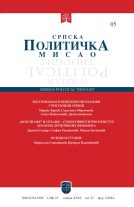- Home page
- Researchers
- Saša Marković
Saša Marković
Pedagoški fakultet, Univerzitet u Novom Sadu

IN SEARCH FOR “CULTURAL NATIONALISM” OF SERBIAN POLITICAL THOUGHT
A text entitled “Cultural Nationalism” written by Isidora Sekulic, prompted contemplation of this topic. It was published in a journal “Novi Srbin” in Sombor in 1912, whose editor was Vasa Stajic. On the eve of the Great War, the Serbian national idea was facing challenges which influenced its modification. Insisting on the cultural content of the national idea was a narrative that has been nurtured for a long time in the territory of present-day Vojvodina, former Southern Hungary. The activity called “Books for the people” by Matica srpska, supervened by work of Tihomir Ostojic, aimed at enriching the national idea with education. In that process, a polemical tone with the stance of national romanticism was developed and was guided more by emotional charge than by the rational balancing of the national idea. All this tell us about a very dynamic process that, in historical circumstances, has specific expressions of manifestation. They may be similar, but they are by no means identical, and in that sense, referring to the analogy was a double-edged sword that made creativity and deliberation not only less effective, but also undesirable. The cultural dimension of the national idea is its expression that corresponded to a specific historical epoch but had one interesting thought in the background, namely the need for continuing education and broadening the horizon of the vision of the national idea. Encouraged by the experience of national struggle, supplemented by new knowledge, responsible for their own and worldly cultural achievements, determined to speak critically about their own weaknesses in order to overcome them, not to nurture them, people like Isidora, Jovan Skerlić, Vas Stajić, Laza Kostić, Tihomir Ostojić, Slobodan Jovanić et al, they sought to strengthen the Serbian identity by offering it modernization, scientific and cultural actuality, intellectual shaping with emotional inspiration. They were open to corrections through the democratic debate of different views, ready to deviate from the improvement offered, but also willing to persevere. Determined in their resistance to ideologization, passion and paroxysm, they nurtured the Serbian national idea in a context of balance. Back to the idea is the need for a modern national expression that is still wandering.

Demographic Circumstances in Serbia: Exaltation and Resignation as two Extremes of the National Identity Crisis
One of the far-reaching consequences of Serbia's involvement in crucial global events and regional conflicts of the twentieth century was its demographic re-composition. The unstable geopolitical situation in the Balkans, which was intentional, drove the people living there into confronting situations, in which they had to act accordingly. The politics of the elite that ran the country (mis)used various models for dealing with its population– from traditionalism and sacrificing, through migration and colonization, to modernization and cosmopolitanism. Each of these models has had its highs and lows. The extremes of these models testified more to senseless wanderings than to a responsible demographic policy. This resulted in an unenviable and almost irreversible demographic decline in Serbia. Unlike today, in the early twentieth century the Serbian nation was considered as one of the youngest in the world, relative to its population size. In this paper we shall present numerous warnings of our contemporaries that the issue of preserving the population is far more important than short-sighted social ideas of the emotionally driven. Unfortunately, this attitude is usually interpreted as an unpatriotic act of dubious intentions. It often took very little time to go from exaltation to resignation. Events have shown that the identity often lacked stability. The irrational elements in creating the identity in Serbia has been and remained one of the greatest challenges of a responsible population policy.

